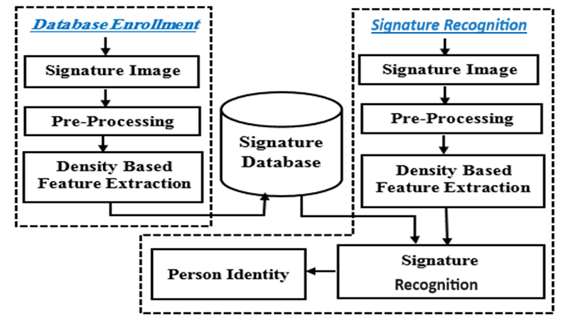Spatial Analysis of Local Statistics for Handwritten Signature Recognition
DOI:
https://doi.org/10.58564/IJSER.3.2.2024.174Keywords:
Handwritten signature, Density-based features, Noise removal, Rotation compensation, Statistical classifier.Abstract
Handwritten signature is one of the most popular distinguishing biometric traits which can be used for secure personal authentication. Many challenges rise for handwritten signature recognition which include complexity of writing the signature (writing style, stroke pattern) also feature extraction and representation that give the best result. In this paper, a handwritten signature recognition system is proposed for static images. The system consists of three primary stages (preprocessing, feature extraction and recognition). In preprocessing stage, image processing methods are applied to remove the undesired noise and extract the signature region (ROI). After that, a new set of spatial-statistical features is determined from extracted ROI body, representing the density of the signature in each image block. The set of introduced features is determined from the spatial domain after partitioning it into overlapped blocks. Then, the spatial-statistical features are determined from each block separately and assembled into one feature vector to represent the tested signature sample. The experimental results showed that the developed system could give recognition accuracy of around 99.81%; when tested on a dataset (SigCom2011) consisting of 612 signature images that belong to 102 persons using visual studio as programming environment.
References
M. Diaz, M. A. Ferrer, D. Impedovo, M. I. Malik, G. Pirlo, and R. Plamondon, “A Perspective Analysis of Handwritten Signature Technology,” ACM Comput. Surv., vol. 51, no. 6, pp. 1–39, Nov. 2019. DOI: https://doi.org/10.1145/3274658
S. Prabhakar, S. Pankanti, and A. K. Jain, “Biometric recognition: security and privacy concerns,” IEEE Secur. Priv., vol. 1, no. 2, pp. 33–42, Mar. 2003. DOI: https://doi.org/10.1109/MSECP.2003.1193209
P. Babita, “Online signature recognition using neural network,” J. Electr. Electron., vol. 4, no. 3, p. 1, 2015.
S. Modi and S. J. Elliott, “Keystroke dynamics verification using a spontaneously generated password,” in Proceedings 40th Annual 2006 International Carnahan Conference on Security Technology , pp. 116–121, 2006. DOI: https://doi.org/10.1109/CCST.2006.313439
M. K. Kalera, S. Srihari, and A. Xu, “Offline signature verification and identification using distance statistics,” Int. J. Pattern Recognit. Artif. Intell., vol. 18, no. 07, pp. 1339–1360, 2004.
J. Coetzer, B. M. Herbst, and J. A. du Preez, “Offline signature verification using the discrete radon transform and a hidden Markov model,” EURASIP J. Adv. Signal Process., vol. 2004, no. 4, pp. 1–13, 2004. DOI: https://doi.org/10.1155/S1110865704309042
M. Arathi and A. Govardhan, “An efficient offline signature verification system,” Int. J. Mach. Learn. Comput., vol. 4, no. 6, p. 533, 2014. DOI: https://doi.org/10.7763/IJMLC.2014.V6.468
L. Lee; T. Berger; and E. Aviczer, “Reliable on-line Human Signature Verification Systems”, IEEE Transactions on Pattern Analysis and Machine Intelligence, Vol. 18, No. 6, Pp. 643-647, June 1996. DOI: https://doi.org/10.1109/34.506415
E. J. R. Justino, F. Bortolozzi, and R. Sabourin, “Off-line signature verification using HMM for random, simple and skilled forgeries,” in Proceedings of Sixth International Conference on Document Analysis and Recognition, pp. 1031–1034, 2001. DOI: https://doi.org/10.1109/ICDAR.2001.953942
A. Sanmorino and S. Yazid, “A survey for handwritten signature verification,” in 2012 2nd International Conference on Uncertainty Reasoning and Knowledge Engineering, pp. 54–57, 2012. DOI: https://doi.org/10.1109/URKE.2012.6319582
M. K. Kalera, S. Srihari, and A. Xu, “Offline signature verification and identification using distance statistics,” Int. J. Pattern Recognit. Artif. Intell., vol. 18, no. 07, pp. 1339–1360, 2004. DOI: https://doi.org/10.1142/S0218001404003630
B. Zhang, “Off-line signature recognition and verification by kernel principal component self-regression,” in 2006 5th International Conference on Machine Learning and Applications (ICMLA’06), pp. 28–33, 2006. DOI: https://doi.org/10.1109/ICMLA.2006.37
S. Ghandali and M. E. Moghaddam, “A method for off-line Persian signature identification and verification using DWT and image fusion,” in 2008 IEEE International Symposium on Signal Processing and Information Technology, pp. 315–319, 2008. DOI: https://doi.org/10.1109/ISSPIT.2008.4775712
D. Banerjee, B. Chatterjee, P. Bhowal, T. Bhattacharyya, S. Malakar, and R. Sarkar, “A new wrapper feature selection method for language-invariant offline signature verification,” Expert Syst. Appl., vol. 186, p. 115756, 2021. DOI: https://doi.org/10.1016/j.eswa.2021.115756
M. Okawa, “Online signature verification using single-template matching with time-series averaging and gradient boosting,” Pattern Recognit., vol. 102, p. 107227, 2020. DOI: https://doi.org/10.1016/j.patcog.2020.107227
L. C. Mai, “Introduction to image processing and computer vision,” Dep. Pattern Recognit. Knowl. Eng. Inst. Inf. Technol. Hanoi, Vietnam, 2010.
M. Sonka, V. Hlavac, and R. Boyle, Image processing, analysis, and machine vision. Cengage Learning, 2014.
L.Teressa, R.K.Dakshina, G.Phalguni ,”Writer independent handwritten signature verification on multi-scripted signatures using hybrid CNN-BiLSTM: A novel approach,” Expert Systems with Applications.,vol 214,p. 119111, 2023. DOI: https://doi.org/10.1016/j.eswa.2022.119111
F. Özyurt, J. Majidpour, T. A. Rashid, and C. Koç, “Offline Handwriting Signature Verification: A Transfer Learning and Feature Selection Approach.” arXiv preprint arXiv:2401.09467 ,2024. DOI: https://doi.org/10.18280/ts.400623
R. C. Gonzalez, Digital image processing. Pearson education india, 2009. DOI: https://doi.org/10.1117/1.3115362
Phillips. D.; "Image Processing in C"; 2nd Edition, R & D Publications, 2000.
K. Sreedhar and B. Panlal, “Enhancement of images using morphological transformation,” arXiv Prepr. arXiv1203.2514, 2012.
W. K. Pratt, Digital image processing: PIKS Scientific inside, vol. 4. Wiley Online Library, 2007. DOI: https://doi.org/10.1002/0470097434
R. Ghosh, “A Recurrent Neural Network based deep learning model for offline signature verification and recognition system,” Expert Syst. Appl., vol. 168, p. 114249, 2021. DOI: https://doi.org/10.1016/j.eswa.2020.114249
S. E. Umbaugh, “Digital image processing and analysis,” computer vision and image analysis. CRC Press.2023. DOI: https://doi.org/10.1201/9781003221135
M. Sonka, V. Hlavac, and R, Boyle, “Image processing, analysis and machine vision,” Springer, 2013.
V. L. F. Souza, A. L. I. Oliveira, R. M. O. Cruz, and R. Sabourin, “A white-box analysis on the writer-independent dichotomy transformation applied to offline handwritten signature verification,” Expert Syst. Appl., vol. 154, p. 113397, 2020. DOI: https://doi.org/10.1016/j.eswa.2020.113397
J. Kollár, Ž .Rohutná,R. Vargic,” Comparative Analysis of Neural Network and Dynamic Time Warping in Online Signature Verification,” In2023 International Symposium ELMAR , Zadar, Croatia, 2023, pp. 197-200. DOI: https://doi.org/10.1109/ELMAR59410.2023.10253924
V. Ruiz, I. Linares, A. Sanchez, and J. F. Velez, “Off-line handwritten signature verification using compositional synthetic generation of signatures and Siamese Neural Networks,” Neurocomputing, vol. 374, pp. 30–41, 2020. DOI: https://doi.org/10.1016/j.neucom.2019.09.041
S. Masoudnia, O. Mersa, B. N. Araabi, A.-H. Vahabie, M. A. Sadeghi, and M. N. Ahmadabadi, “Multi-representational learning for offline signature verification using multi-loss snapshot ensemble of CNNs,” Expert Syst. Appl., vol. 133, pp. 317–330, 2019. DOI: https://doi.org/10.1016/j.eswa.2019.03.040
M. Abdel-Basset, “Doaa El-Shahat, Ibrahim El-henawy, Victor Hugo C. de Albuquerque, and Seyedali Mirjalili." A new fusion of grey wolf optimizer algorithm with a two-phase mutation for feature selection.",” Expert Syst. Appl., vol. 139, p. 112824, 2020. DOI: https://doi.org/10.1016/j.eswa.2019.112824

Downloads
Published
How to Cite
Issue
Section
License
Copyright (c) 2024 Suphian Mohammed Tariq

This work is licensed under a Creative Commons Attribution-ShareAlike 4.0 International License.
Deprecated: json_decode(): Passing null to parameter #1 ($json) of type string is deprecated in /var/www/vhosts/ijser.aliraqia.edu.iq/httpdocs/plugins/generic/citations/CitationsPlugin.inc.php on line 49









